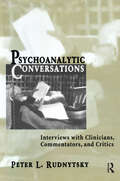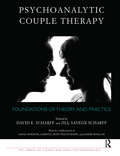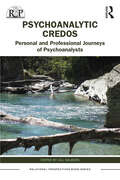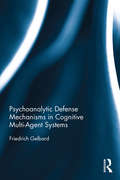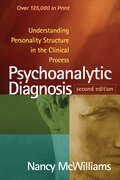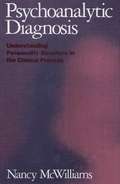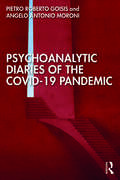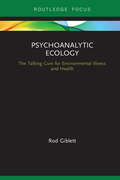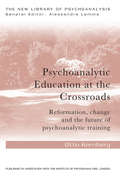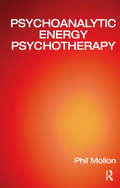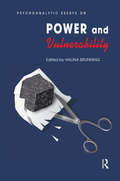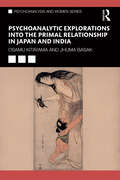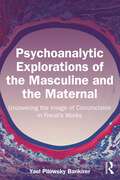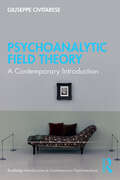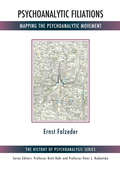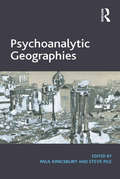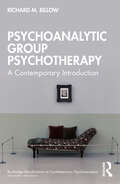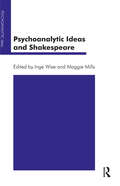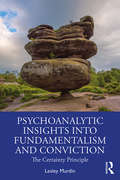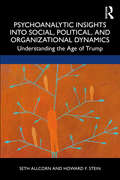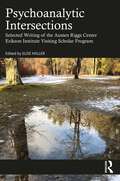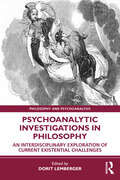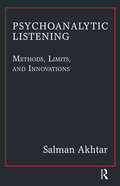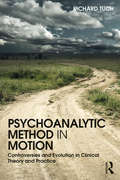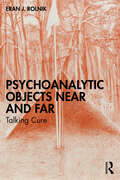- Table View
- List View
Psychoanalytic Conversations: Interviews with Clinicians, Commentators, and Critics
by Peter L. RudnytskyIn this stunning addition to what has of late become a distinct genre of psychoanalytic literature, Peter Rudnytsky presents 10 substantive and provocative interviews with leading analysts, with theorists from allied fields, and with influential Freud critics. In conversations that Rudnytsky succeeds in making psychoanalytic both in form and in content, he guides his interlocutors to unforeseen reflections on the events and forces that shaped their lives, and on the personal and intellectual grounds of their beliefs and practices. Rudnytsky, a ranking academic scholar of psychoanalysis and the humanities, approaches his subjects with not only a highly attuned third ear but also a remarkable grasp of theoretical, historical, and clinical issues. When his interviewees turn from autobiographical narratives to matters of theory and clinical practice, Rudnytsky is clear about his own intellectual allegiance to the Independent tradition of object relations theory and his admiration for John Bowlby and attachment theory. His willingness to set forth his own point of view and occasionally to press a line of questioning infuses his exchanges with an energy, even passion, heretofore unknown in the analytic interview literature. Rudnytsky consistently emerges as a partner, even an analytic partner, in dialogues that meld discovery with self-discovery. To be sure, Psychoanalytic Conversations will find many clinical and scholarly readers among those who relish a good engrossing read. But it will have special appeal to students of analysis who share Rudnytsky's belief that if psychoanalysis is to remain vital in the new century, "it can only be by expanding its horizons and learning from those who have taken it to task."
Psychoanalytic Couple Therapy: Foundations of Theory and Practice (The Library of Couple and Family Psychoanalysis)
by Jill Savege Scharff David E. ScharffIn this time of vulnerable marriages and partnerships, many couples seek help for their relationships. Psychoanalytic couple therapy is a growing application of psychoanalysis for which training is not usually offered in most psychoanalytic and analytic psychotherapy programs. This book is both an advanced text for therapists and a primer for new students of couple psychoanalytic psychotherapy. Its twenty-eight chapters cover the major ideas underlying the application of psychoanalysis to couple therapy, many clinical illustrations of cases and problems in various dimensions of the work. The international group of authors comes from the International Psychotherapy Institute based in Washington, DC, and the Tavistock Centre for Couple Relationships (TCCR) in London. The result is a richly international perspective that nonetheless has theoretical and clinical coherence because of the shared vision of the authors.
Psychoanalytic Credo: Personal and Professional Journeys of Psychoanalysts (Relational Perspectives Book Series)
by Jill SalbergDeveloping a psychoanalytic credo, a set of beliefs that inform how you listen and approach the analytic enterprise with patients, is in many ways the scaffolding of psychoanalytic training. Drawing upon Mannie Ghent’s original Credo essay, 27 psychoanalysts were asked to write their credo and/or their psychoanalytic journey. This book represents a multi-theoretical and multi-generational grouping, trained at different institutes, during different eras (grouped by decades 1960-2000) and across cultures. They are drawn from analysts identified with Relational, Object Relations, Contemporary Freudians and Kleinian/Bionian perspectives as well as those who don’t easily fit categorization. This book serves to provide companionship to analysts in training, as part of reading lists in institutes as well as analysts post-training and yet still evolving in their psychoanalytic journey.
Psychoanalytic Defense Mechanisms in Cognitive Multi-Agent Systems
by Friedrich GelbardHuman cognitive processes and defense mechanisms, as described in psychoanalysis, bring about new notions and paradigms for artificial intelligence systems. One key reason is that the human cognitive processes and defense mechanisms in question can accomplish conflict detection functionalities, filter functionalities, and other system stabilizing tasks within artificial intelligence systems. Yet artificial cognitive architectures lack the capability to analyze complex situations as well as the universal competencies needed to orientate themselves in complex environments in various domains. Psychoanalytic Defense Mechanisms in Cognitive Multi-Agent Systems addresses this dilemma by exploring how to describe, model, and implement psychoanalytic defense mechanisms in the course of a project that provides a functional model of the human mind. With discussions focusing on the development of a mathematical description for the implementation of conflict detection, the activation and selection of defense mechanisms, and the processing of defense mechanisms, Psychoanalytic Defense Mechanisms in Cognitive Multi-Agent Systems describes the decisive points for the application of defense mechanisms in artificial intelligence. Formulae that treat defense mechanisms as transformations are also provided. Interdisciplinary cooperation between the scientific fields of psychoanalysis and artificial intelligence is highlighted as the foundation of new research findings throughout the book. Innovative and exciting, this book will be of great interest to academics, researchers, and postgraduates in the fields of cognitive science, artificial intelligence, and psychoanalysis.
Psychoanalytic Diagnosis, Second Edition: Understanding Personality Structure in the Clinical Process
by Nancy McwilliamsThis acclaimed clinical guide and widely adopted text has filled a key need in the field since its original publication. Nancy McWilliams makes psychoanalytic personality theory and its implications for practice accessible to practitioners of all levels of experience. She explains major character types and demonstrates specific ways that understanding the patient's individual personality structure can influence the therapist's focus and style of intervention. Guidelines are provided for developing a systematic yet flexible diagnostic formulation and using it to inform treatment. Highly readable, the book features a wealth of illustrative clinical examples. New to This Edition Reflects the ongoing development of the author's approach over nearly two decades. Incorporates important advances in attachment theory, neuroscience, and the study of trauma. Coverage of the contemporary relational movement in psychoanalysis. *A number of the case examples are entirely new.
Psychoanalytic Diagnosis: Understanding Personality Structure in the Clinical Process
by Nancy McwilliamsPresents a psychoanalytic personality theory and its implications for beginning practitioners. Explains the major clinically important character types and suggest how an appreciation of individual personality structure should influence the therapist's style of intervention. Covers conceptual issues such as developmental levels of personality organization, primary and secondary defensive processes, types of character organization, borderline syndromes, and dissociative disorders.
Psychoanalytic Diaries of the COVID-19 Pandemic
by Pietro Roberto Goisis Angelo Antonio MoroniThis intimate book explores the experiences of two psychoanalysts during the COVID-19 pandemic. It presents Angelo Antonio Moroni’s psychoanalytic diary and Pietro Roberto Goisis’s clinical diary, two highly personal perspectives that explore the interplay of the personal and the psychoanalytic during a time of collective trauma. Angelo’s account, written from his ‘camp tent’, examines how fundamental, time-tested procedures are suddenly questioned. Roberto’s diary is the story of his own experience as a COVID patient, the mutually therapeutic caring relationships he encounters and his efforts to keep his analytical expertise alive and well. The two accounts share painful and graphic experiences of the trauma of the pandemic, and how the authors were forced to reconsider the issues of analytical ‘asymmetry’ and ‘neutrality’. Psychoanalytic Diaries of the COVID-19 Pandemic will be of great interest to psychoanalysts in practice and in training, and to readers with an interest in clinical and personal accounts of the COVID-19 pandemic.
Psychoanalytic Ecology: The Talking Cure for Environmental Illness and Health (Routledge Focus on Environment and Sustainability)
by Rod GiblettPsychoanalytic Ecology applies Freudian concepts, beginning with the uncanny, to environmental issues, such as wetlands and their loss, to alligators and crocodiles as inhabitants of wetlands, and to the urban underside. It also applies other Freudian concepts, such as sublimation, symptom, mourning and melancholia, to environmental issues and concerns. Mourning and melancholia can be experienced in relation to wetlands and to their loss. The city is a symptom of the will to fill or drain wetlands. This book engages in a talking cure of psychogeopathology (environmental psychopathology; mental land illness; environ-mental illness) manifested also in industries, such as mining and pastoralism, that practice greed and gluttony. Psychoanalytic Ecology promotes gratitude for generosity as a way of nurturing environ-mental health to prevent the manifestation of these psychogeopathological symptoms in the first place. Melanie Klein’s work on anal sadism is applied to mining and Karl Abraham’s work on oral sadism to pastoralism. Finally, Margaret Mahler’s and Jessica Benjamin’s work on psycho-symbiosis is drawn on to nurture bio- and psycho-symbiotic livelihoods in bioregional home habitats of the living earth in the symbiocene, the hoped-for age superseding the Anthropocene. Psychoanalytic Ecology demonstrates the power of psychoanalytic concepts and the pertinence of the work of several psychoanalytic thinkers for analysing a range of environmental issues and concerns. This book will be of great interest to students and scholars of environmental psychology, psychoanalysis and the environmental humanities.
Psychoanalytic Education at the Crossroads: Reformation, change and the future of psychoanalytic training (The New Library of Psychoanalysis)
by Otto Friedmann KernbergTraining in psychoanalysis is a long and demanding process. However, the quality of education available is hugely variable across the world. The structure of psychoanalytic education, centered on the hierarchical "training analysis" system, reflected a concerted effort to maintain a stable and high quality educational process. However, throughout time this system has become a major source of institutional contradictions that affect the training of candidates, the scientific developments within psychoanalysis, and the nexus of psychoanalytic theory and practice with the surrounding scientific, social and cultural world. Psychoanalytic Education at the Crossroads examines the ways in which group processes, the hierarchal culture in institutes, the influence of individual personalities, the lack of research and the faults in supervision can all stifle creativity and hinder candidates’ progress. In this compelling work, Otto Kernberg sets out clear suggestions for how these issues can be addressed, and how he sees the future of psychoanalytic education across all psychoanalytic settings and schools of thought. The first part of this volume is focused primarily on the analysis of the nature of these problems and their effects on the personal analysis and supervision of candidates; on theoretical and clinical seminars; on selection, progression, and graduation; on educational principles and requirements, developments of theory and technique and, in particular, limitation versus expansion of the realm of interests and applications of psychoanalysis. The second part of this volume deals with proposals of solutions to the problems encountered, and major suggestions for innovation in psychoanalytic education. The author’s work in this area has been hugely influential. Kernberg has made a substantive difference in the development of psychoanalytic institutes and education, and continues to do so. Psychoanalytic Education at the Crossroads will be essential reading to anyone involved in psychoanalytic education, whether as a psychoanalyst, psychoanalytic psychotherapist, trainee, trainer, or supervisor.
Psychoanalytic Energy Psychotherapy: Inspired By Thought Field Therapy, Eft, Tat, And Seemorg Matrix
by Phil MollonPeople like to talk. We know that talking to an attentive and thoughtful listener can be helpful in clarifying conscious and unconscious feelings, thoughts, and motivations. But is talk enough? The complex physiology of anxiety and traumatic stress reactions is often stubbornly persistent, despite therapeutic exploration in both conscious and unconscious areas of the mind. In the case of severe trauma, talking can stir up the emotions and associated bodily disturbance without providing any resolution - sometimes leaving clients feeling worse. The developing field of energy psychology offers an entirely new perspective and gamut of techniques for locating where these traumatic patterns are encoded. They are not in the mind - but in the energy system at the interface of psyche and soma. By addressing these realms concurrently, a powerful therapeutic synergy emerges that allows rapid and deep shifts in the patterns of distress that drive the psychosomatic system.
Psychoanalytic Essays on Power and Vulnerability
by Halina Brunning"This paper is based on research into European economics and politics on the basis of ten months travelling in ten countries, as well as on four workshops run in Europe. Two hypotheses will be explored: It is possible to discern psychodynamic evidence that unresolved humiliation trauma is being re-evoked and recycled by attempts to find solutions and cures through the tyranny of austerity measures. But the question will be asked whether these are “chosen trauma” (Volkan, 2010) which may be at the heart of the foundation matrix (Foulkes, 1973) of the European Community. The exploration of political and economic leadership in the crisis in the European Union builds on the notion of society as a large group proliferating crises of identity. From a systemic perspective it is possible to analyse the nation states of Europe protesting with regressive nationalism, refusing collaboration by engaging in economic warfare while at the same time attempting rescue packages. The protest could be seen as defensive denial of their humbling at the hands of the over-ambitious aspects of the European single currency project and the demise of the potency of the nation state. The concluding section reflects on these issues and tries to distinguish the recycling of humiliation trauma from defence against the experience of being humbled."
Psychoanalytic Explorations into the Primal Relationship in Japan and India (Psychoanalysis and Women Series)
by Jhuma Basak Osamu KitayamaIn this landmark collaboration, Osamu Kitayama and Jhuma Basak chronical their long-standing collaboration and cultural exchange to survey the importance of familial relationships in Japan and India, exploring primal relations through a cross-cultural psychoanalytic lens.Divided into three sections, Psychoanalytic Explorations into the Primal Relationship in Japan and India looks at each country’s perception of parenthood and approach to raising children in turn before concluding in an illuminating dialogue between the two authors. Kitayama explores the maternal figure within the mother-child relationship, with a focus on the mother-son dyad, as well as relationships between parents. He considers, in depth, how Japanese culture can often exclude what is perceived as alien, delving into its rich tapestry of folklore to understand underlying ‘mental scripts’ which can shape collective perceptions, societal norms and expectations, each of which can pose an issue to healthy familial relationships. Basak’s response draws from Indian socio-cultural and mythological contexts, as well as clinical applications, to provide psychoanalytic insight into the stark differences and similarities between attitudes in Japan, India and the eastern culture at large. Both authors join together to highlight different child rearing practises such as co-sleeping and how they can shape human sexuality-subjectivity. Challenging the standardisation of the Oedipal myth, the book draws from literary and clinical examples in Japan and India to invite the reader into another world of parenting style and another idiom of psychoanalysis. Uniquely positioned to develop understanding of how psychoanalysis has developed in non-Western countries, this book is an essential resource for psychoanalysts in training and in practice.
Psychoanalytic Explorations of the Masculine and the Maternal: Uncovering the Image of Circumcision in Freud’s Works
by Yael Pilowsky BankirerIn this book, Yael Pilowsky Bankirer reads into Freud's writings with the unique prism of circumcision as a marker for both the formation of masculine identity, and for matricide, the disappearance of the mother.Pilowsky Bankirer uses Freud’s idea of circumcision within a text as a Leitfossil: a key-fossil through which an unresolved unconscious conflict can be traced. She conducts a close reading of Freud’s texts – including Little Hans, The Wolf Man, Totem and Taboo and Moses and Monotheism – to illuminate and uncover the textual unconscious, deconstruct the explicit narrative and open alternative psychoanalytic possibilities inherent to the encounter with the maternal realm. Throughout the volume, Pilowsky Bankirer informs her analysis by considering the work of Freud in tandem with that of Lacan, Kristeva, Irigaray, Derrida, Benjamin, Butler and more.Psychoanalytic Explorations of the Masculine and the Maternal: Uncovering the Image of Circumcision in Freud’s Works will be of interest to scholars of psychoanalysis and practising analysts alike, particularly those interested in the intersection of gender studies and psychoanalysis.
Psychoanalytic Field Theory: A Contemporary Introduction (Routledge Introductions to Contemporary Psychoanalysis)
by Giuseppe CivitareseWritten by one of the world’s renowned Bionian Field Theory scholars, this foundational volume provides a thorough introduction to all facets of psychoanalytic field theory, one of the most lively and original currents of thought in contemporary psychoanalysis, to offer new answers to age-old questions around how psychic change occurs. With clinical examples to illuminate key themes of therapeutic effectiveness, current controversies, and future developments, the book presents a radically intersubjective view of the analytic process that focuses on the plane of unconscious communication common to both analyst and patient, moving beyond the I/you division to access the shared substance of the psyche. It centers the unconscious not as a hellish region of the psyche but as an important function of the personality that gives meaning to emotional experience. Offering clear expositions of complex concepts and linking to more detailed sources of information, this book is important reading for all clinicians, trainees, and students interested in contemporary psychoanalysis.
Psychoanalytic Filiations: Mapping the Psychoanalytic Movement (The History of Psychoanalysis Series)
by Ernst FalzederThis book presents a collection of fifteen essays on the early history of psychoanalysis, focusing on the network of psychoanalytic "filiations" ("who analysed whom") and the context of discovery of crucial concepts, such as Freud's technical recommendations, the therapeutic use of countertransference, the introduction of the anal phase, the birth of the object-relations-model as opposed to the drive-model in psychoanalysis, and the psychotherapeutic treatment of psychoses. Several chapters deal with key figures in that history, such as Sandor Ferenczi, Karl Abraham, Eugen Bleuler, Otto Rank, and C.G. Jung, their respective relationship to Freud, and the consequences that their collaboration - as well as conflicts - with him had for the further development of psychoanalysis up to the present day. Other chapters give an overview of the publications of Freud's texts and of unpublished documents (the "unknown Freud"), the editorial policy of the publications of Freud's letters, and the question of Freud's negative attitude toward America.
Psychoanalytic Geographies
by Steve Pile Paul KingsburyPsychoanalytic Geographies is a unique, path-breaking volume and a core text for anyone seeking to grasp how psychoanalysis helps us understand fundamental geographical questions, and how geographical understandings can offer new ways of thinking psychoanalytically. Elaborating on a variety of psychoanalytic approaches that embrace geographical imaginations and a commitment toward spatial thinking, this book demonstrates the breadth, depth, and vitality of cutting edge work in psychoanalytic geographies and presents readers with as wide a set of options as possible for taking psychoanalysis forward in their own work. It covers a wide range of themes and perspectives in terms of theoretical approaches such as Freudian, Lacanian, Kristevan, and Irigarayian; conceptual issues such as space, power, identity, culture, political economy, colonialism, ethics, and aesthetics; disciplinary insights including Geography, English, Sexuality Studies, and History of Science; as well as empirical contexts such as the reception of psychoanalysis in early twentieth century England, psychoanalytic geographies of violence and creativity in a small Mexican city, visual cultures of second-generation Iranian artists living in Los Angeles, and the hysterical underpinnings of climate change scepticism.
Psychoanalytic Group Psychotherapy: A Contemporary Introduction (Routledge Introductions to Contemporary Psychoanalysis)
by Richard M. BillowIn this comprehensive volume, Richard M. Billow provides a thorough introduction to group psychotherapy from a psychoanalytic perspective. Billow integrates contemporary psychoanalytic thinking with Freudian and Kleinian core concepts, as well as Bion’s early group theory and his later metapsychology, to provide a holistic overview of group therapy and its potential benefits for patients. He incorporates major psychoanalytic thinkers outside the American relational mainstream – such as Lacan, Laplanche, Kaes, Foulkes, and Pichon Riviere, as well as his own prominent contributions to the field – to provide a unique and interdisciplinary overview. Throughout the chapters, readers will be introduced to challenging clinical experiences that illustrate some of the similarities and differences among psychoanalytic and other psychodynamic group approaches. Offering guidelines on how to harness and conduct the group, Billow provides exceptional insight into the veritable benefits of maintaining an analytic stance within the clinical setting. Written in a clear and accessible style, this book is a vital tool for students and professionals interested in a thorough overview of psychoanalytically-based group treatments.
Psychoanalytic Ideas and Shakespeare (The Psychoanalytic Ideas Series)
by Inge Wise Maggie MillsPsychoanalysis is concerned with the vicissitudes of life: loss, grief, mourning, guilt and also with reparation and creativity, with death and rebirth, as is the work of Shakespeare. These papers link the Bard's universe to psychoanalytic thought and practice and show us how much both worlds have in common. In today's world we are moved by Shakespeare's plays whose themes are brought to life with a richness and creativity that has not dimmed with the passing of time. Echoing Freud's fascination with Shakespeare, Michael Conran, Peter Hildebrand, Gerald Wooster, and Peter Buckroyd find much to feast on in King Lear, Twelfth Night, All's Well That Ends Well, The Tempest, Macbeth, and The Winter's Tale. The interplay of inner and outer world, inner and outer reality, brings about a rich tapestry of conflicts, desires, anxieties, challenges and resolutions that were as true then as they are now.
Psychoanalytic Insights into Fundamentalism and Conviction: The Certainty Principle
by Lesley MurdinPsychoanalytic Insights into Fundamentalism and Conviction: The Certainty Principle examines the role of, and need for, certainty in mental life, addressing questions raised by fundamentalism and extremism and exploring its relation to human nature. Murdin proposes a new synthesis in which certainty itself can be a cause of suffering and part of a defensive manoeuvre, and considers how the need for certainty can be managed in a positive way, rather than creating fear and extreme emotional responses. Illustrated throughout with examples from psychotherapy practice, literature and international politics, this book considers how the quest for certainty dominates much of human thinking. Murdin examines personal relationships, including politics and religion, where assumptions are taken for granted but function to hide fears and doubts, and argues that fundamentalist elements can generate harm in anyone but can be mitigated with understanding and work in therapy. Psychoanalytic Insights into Fundamentalism and Conviction helps to identify the underlying convictions that are causing mental harm. It is essential reading for psychotherapists, psychoanalysts and counsellors in practice and in training, and will be of interest to readers interested in fundamentalist states of mind.
Psychoanalytic Insights into Social, Political, and Organizational Dynamics: Understanding the Age of Trump
by Seth Allcorn Howard F SteinThis fascinating interdisciplinary work explores U.S. politics since 2015 and offers psychodynamic insights into the unconscious undercurrents of contemporary culture and politics in the United States. Allcorn and Stein expertly lead readers up the steep learning curve of understanding the Trump era by exploring seven key elements of recent political dynamics. Using the complementary psychodynamic models of object relations, Group Relations and Karen Horney’s tripartite theory, this book makes sense of the Age of Trump and its chaotic world of alternate facts, conspiracy theories, reality TV politics, hoax pandemics, and the sweeping chaos of life in the United States. This sense-making relies on two triangulations. The first represents the complex systemic political scene. The second uses three psychoanalytic theories to understand social, political, and organizational dynamics. This book is a key resource for helping readers know and understand ourselves, our fellow citizens, colleagues, family, friends and what Trump and his followers call "them" such as liberals and foreign immigrants, as well as both the larger polarized social and political context in the United States today. The book also provides concrete examples of how these discoveries can be operationalized both in organizations and at the level of national government and leadership. This book is an essential reading for students in organizational behavior including leadership and how governments operate, as well as behavioral health professionals consulting or offering therapy to organizations.
Psychoanalytic Intersections: Selected Writing of the Austen Riggs Center Erikson Institute Visiting Scholar Program
by Elise MillerPsychoanalytic Intersections examines the influence and legacy of the Austen Riggs Center, one of the oldest psychoanalytically oriented psychiatric hospitals in America, and home of the Erikson Institute for Education and Research. Former Erikson scholar Elise Miller brings together the work of a wide range of clinicians and scholars who have participated in the Erikson Institute’s Visiting Scholars Program. Representing a variety of disciplines, departments, and methodologies, the contributors exemplify the cutting edge of interdisciplinary work at the intersections of psychoanalysis and academia, psychiatry, psychology, psychoanalysis, and hospital and private practice settings. For this unique collection, each contributor has selected a piece of their published work to be presented with a new afterword reflecting on how time spent in a clinical setting shaped their thinking and writing. These personal narratives also offer a unique opportunity to consider how this kind of scholarship was produced, and what it can teach us about the disciplinary crossings and migrations of applied psychoanalysis, especially as it continues to extend its insights and influences out into the world around us. Psychoanalytic Intersections will be of great interest to psychoanalytic clinicians, psychiatrists, and psychologists engaged in cross-disciplinary work, and to academics and scholars of interdisciplinary psychoanalytic studies.
Psychoanalytic Investigations in Philosophy: An Interdisciplinary Exploration of Current Existential Challenges (Philosophy and Psychoanalysis)
by Dorit LembergerThis pioneering volume explores and exemplifies the relevance of psychoanalysis to contemporary philosophical problems. The novelty of the book's viewpoint is the consideration of psychoanalysis as an existentialist mode of thinking that deals with current existential problems such as loneliness, uncertainty, struggling with personal tragedies and rehabilitation. Each chapter presents classic aspects of psychoanalytic theory based on Greek tragedies, as well as their similarities with interdisciplinary aspects in other areas of study like modern literature, hermeneutics, and philosophy of language. To deepen each subject, each chapter also applies an interdisciplinary methodology that illuminate previously hidden insights arising from the fusion of psychoanalysis and philosophy. Featuring contributions from well-known scholars like Professor Avi Sagi and Professor Dov Schwartz, as well as more up-and-coming writers, the book suggests possible implications of philosophical, hermeneutical, and literary theories to the perception of post-modern issues concerning agency and the subjective emotional world. Psychoanalytic Investigations in Philosophy is of great interest to scholars of psychoanalysis and hermeneutic philosophy, as well as teachers and academics who want to explore new teaching methods in various disciplines, and general-interest readers who wish to expand their horizons around concepts that can be applied to better understand themselves and the age in which we live.
Psychoanalytic Listening: Methods, Limits, and Innovations
by Salman Akhtar'Joseph Breuer's celebrated patient, Anna O., designated psychoanalysis to be a "talking cure". She was correct insofar as psychoanalysis does place verbal exchange at the center stage. However, the focus upon the patient's and therapist's speaking activities diverted attention from how the two parties listen to each other. Psychoanalysis is a listening and talking cure. Both elements are integral to clinical work. Listening with no talking can only go so far. Talking without listening can mislead and harm. And yet, the listening end of the equation has received short shrift in analytic literature. This book aims to rectify this problem by focusing upon analytic listening. Taking Freud's early description of how an analyst ought to listen as its starting point, the book traverses considerable historical, theoretical, and clinical territory. The ground covered ranges from diverse methods of listening through the informative potential of the countertransference to the outer limits of our customary attitude where psychoanalytic listening no longer helps and might even be contraindicated.'- Salmon Akhtar, from his Introduction
Psychoanalytic Method in Motion: Controversies and evolution in clinical theory and practice
by Richard TuchPsychoanalytic Method in Motion identifies and examines varied controversies about how psychoanalysts believe treatment should best be conducted. Irrespective of their particular school of thought, every analyst builds up a repertoire of his favored ways of working, which some analysts come to see as the most efficacious approach to treatment available. While such differences of opinion are unsettling, and may even threaten to tear the field asunder, this book sees these differences as benefitting psychoanalysis by improving the ways in which psychoanalysts and psychoanalytic psychotherapists practice. In this book, Richard Tuch covers the waterfront by examining controversies that further the field by raising questions that help evolve the treatment, challenging every analyst to re-think what they are doing in the consulting room…and why. Some of the chief controversies explored include: the enactment debate—unparalleled tool or regrettable error? whether analysts can truly be "objective"—whatever that means the advantages and disadvantages arising from the analyst’s use of authority the ways in which theory influences the analyst’s search for data—blinding him to evidence he implicitly discards as irrelevant whether any given treatment approach is more efficacious than others, as some analysts claim the legitimacy of psychoanalysis itself—whether it can truly be considered scientific whether certain methods of supervision are more effective than others whether free association can be considered therapeutic in and of itself the extent to which an analyst preferred clinical theory is a product of his personality Drawing on ideas from a range of different analytic perspectives, this book is an essential and accessibly written guide to working towards best practice in the analytic setting. Psychoanalytic Method in Motion will appeal greatly to both students and practitioners of psychoanalysis and psychoanalytic psychotherapy.
Psychoanalytic Objects Near and Far: Talking Cure
by Eran J. RolnikTouching upon the most sensitive nuances of the analytic encounter, Psychoanalytic Objects Near and Far combines a far-reaching theoretical manifesto with an intimate clinical journal to express curiosity, skepticism and love towards the psychoanalytic clinic, theory and history. Basic concepts and controversies that often become a conceptual ivory tower receive here a new and fresh vitality from the perspective of an experienced clinician, scholar and teacher, all while crossing the boundary of theoretical fantasy. While holding theory as central to the clinical act, Rolnik does not see it as a self-sufficient philosophy, detached from the free spirit of psychoanalysis as a practice and ethics. Rolnik has no need for iconoclasm. He is committed to the curative speech – his patients’ and his own – as well as receptiveness to the unconscious space in the most Freudian sense of the word. This volume will be of great interest to analysts in practice and in training, and to any reader interested in the analytic process.
